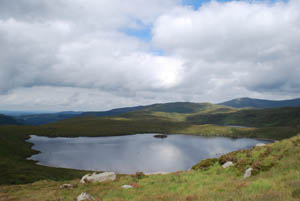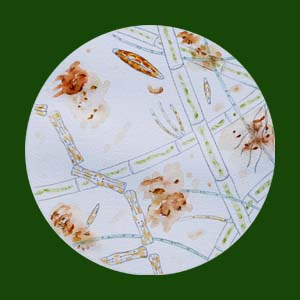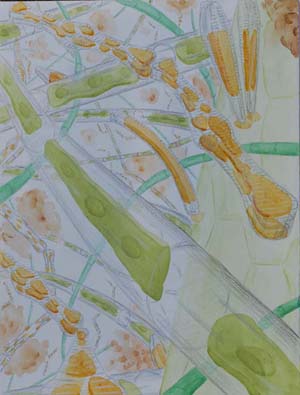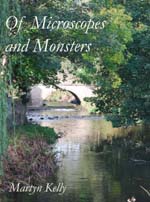
This is a lake in a granite catchment in
Galloway, south-west Scotland, which was the focus of a number of
studies in the 1970s and 80s. Palaeolimnological studies showed that
the loch was naturally acid (pH ~5.5), but had become more acid from
approximately 1850 onwards (pH <5.0), due to acid rain. As a
result of legislation on sulphur emissions, introduced partly as a
result of these studies, the pH gradually increased and there has
also been a shift in the ecology although, interestingly, not back
towards the assemblage associated with pre-impact conditions.

Submerged stones and plant stems in the littoral region of
the lake were surrounded by a dark brown translucent cloud,
but as soon as I scooped it out of the water, it collapsed into an
amorphous slimy gunk. are now coated with an amorphous, slimy brown
gunk. There is anecdotal evidence (R. Flower,
unpublished) that these brown growths were either absent or much
less conspicuous in the late 1970s and early 1980s when regular
visits to the loch started.

Staring down my microscope at a sample of this gunk, I could see a rich mixture of algae. There were long
filaments of a green alga called
Mougeotia – cells whose chloroplasts were flat plates, which could rotate round
the central axis of the cell in order to catch as much light as possible. Tangled around this were much thinner
filaments of a blue-green alga called
Lyngbya –a close relative of the
Phormidium which we met in the River Wear,
and chains of
 Tabellaria,
Tabellaria, albeit a different species to the one we met in Wastwater. Within this tangled web,
there were other algae:
Merismopeodia, an ordered array of blue-green cells within a mucilaginous matrix; elegant
vase-shaped cells of
Dinobryon and, creeping through this tangle, diatoms. One was a species of
Navicula but
there were also larger boat-shaped cells – some almost a tenth of a millimetre long – of a type known as
Frustulia.
And, to complete this submerged melange, there were trapped particles of peat, washed in from the catchment, and
responsible for the dark brown colour of the gunk. Attached to the plant stems, I saw several cells of small,
asymmetrical diatoms belonging to a genus called
Eunotia, along with needle-shaped cells of another genus,
Peronia.
 This is a lake in a granite catchment in
Galloway, south-west Scotland, which was the focus of a number of
studies in the 1970s and 80s. Palaeolimnological studies showed that
the loch was naturally acid (pH ~5.5), but had become more acid from
approximately 1850 onwards (pH <5.0), due to acid rain. As a
result of legislation on sulphur emissions, introduced partly as a
result of these studies, the pH gradually increased and there has
also been a shift in the ecology although, interestingly, not back
towards the assemblage associated with pre-impact conditions.
This is a lake in a granite catchment in
Galloway, south-west Scotland, which was the focus of a number of
studies in the 1970s and 80s. Palaeolimnological studies showed that
the loch was naturally acid (pH ~5.5), but had become more acid from
approximately 1850 onwards (pH <5.0), due to acid rain. As a
result of legislation on sulphur emissions, introduced partly as a
result of these studies, the pH gradually increased and there has
also been a shift in the ecology although, interestingly, not back
towards the assemblage associated with pre-impact conditions. Submerged stones and plant stems in the littoral region of
the lake were surrounded by a dark brown translucent cloud,
but as soon as I scooped it out of the water, it collapsed into an
amorphous slimy gunk. are now coated with an amorphous, slimy brown
gunk. There is anecdotal evidence (R. Flower,
unpublished) that these brown growths were either absent or much
less conspicuous in the late 1970s and early 1980s when regular
visits to the loch started.
Submerged stones and plant stems in the littoral region of
the lake were surrounded by a dark brown translucent cloud,
but as soon as I scooped it out of the water, it collapsed into an
amorphous slimy gunk. are now coated with an amorphous, slimy brown
gunk. There is anecdotal evidence (R. Flower,
unpublished) that these brown growths were either absent or much
less conspicuous in the late 1970s and early 1980s when regular
visits to the loch started.  Staring down my microscope at a sample of this gunk, I could see a rich mixture of algae. There were long
filaments of a green alga called Mougeotia – cells whose chloroplasts were flat plates, which could rotate round
the central axis of the cell in order to catch as much light as possible. Tangled around this were much thinner
filaments of a blue-green alga called Lyngbya –a close relative of the
Phormidium which we met in the River Wear,
and chains of
Staring down my microscope at a sample of this gunk, I could see a rich mixture of algae. There were long
filaments of a green alga called Mougeotia – cells whose chloroplasts were flat plates, which could rotate round
the central axis of the cell in order to catch as much light as possible. Tangled around this were much thinner
filaments of a blue-green alga called Lyngbya –a close relative of the
Phormidium which we met in the River Wear,
and chains of
 Tabellaria, albeit a different species to the one we met in Wastwater. Within this tangled web,
there were other algae: Merismopeodia, an ordered array of blue-green cells within a mucilaginous matrix; elegant
vase-shaped cells of Dinobryon and, creeping through this tangle, diatoms. One was a species of
Navicula but
there were also larger boat-shaped cells – some almost a tenth of a millimetre long – of a type known as
Frustulia.
And, to complete this submerged melange, there were trapped particles of peat, washed in from the catchment, and
responsible for the dark brown colour of the gunk. Attached to the plant stems, I saw several cells of small,
asymmetrical diatoms belonging to a genus called Eunotia, along with needle-shaped cells of another genus,
Peronia.
Tabellaria, albeit a different species to the one we met in Wastwater. Within this tangled web,
there were other algae: Merismopeodia, an ordered array of blue-green cells within a mucilaginous matrix; elegant
vase-shaped cells of Dinobryon and, creeping through this tangle, diatoms. One was a species of
Navicula but
there were also larger boat-shaped cells – some almost a tenth of a millimetre long – of a type known as
Frustulia.
And, to complete this submerged melange, there were trapped particles of peat, washed in from the catchment, and
responsible for the dark brown colour of the gunk. Attached to the plant stems, I saw several cells of small,
asymmetrical diatoms belonging to a genus called Eunotia, along with needle-shaped cells of another genus,
Peronia. 


